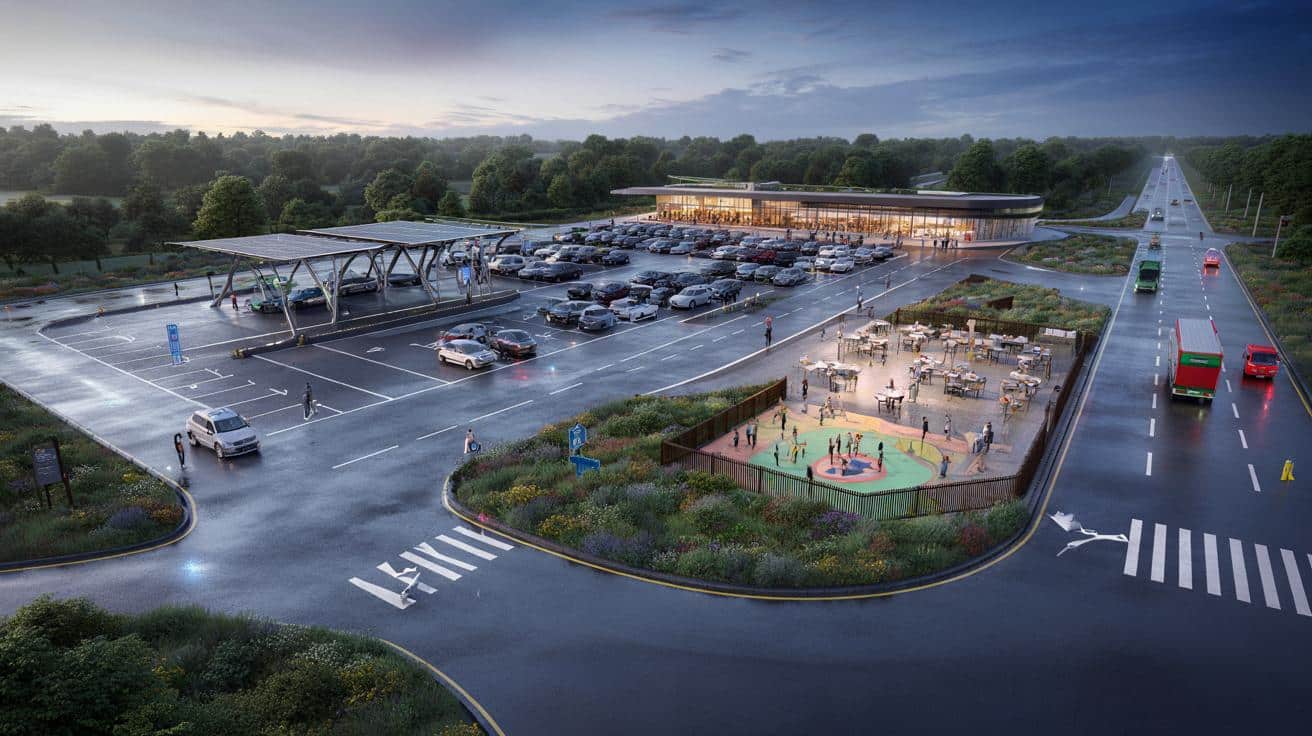Long hours behind the wheel meet a simple promise: stop, breathe, reset.
Rain stitched the windscreen as families and truckers funneled into an overburdened services, every bay spoken for, hazard lights blinking like a stressed-out chorus. I watched a dad scan for a space with one hand on the wheel and the other passing snacks backwards, while a lorry eased past, its driver mapping the asphalt like a chessboard. We’ve all had that moment when the hard shoulder starts to look like an option, and you know that’s not good. On the forecourt, strangers traded nods that said: we’re all just trying to get somewhere. A new, better stop is on the way. The question is what “better” really means.
The big stop: what’s actually planned
The blueprint paints scale and clarity. The car park stretches to 550 spaces, with separate zones for cars, HGVs and coaches so the dance of reversing trailers doesn’t meet the school run. Expect lanes that flow, not circle. Planners talk about wide aisles, step-free routes, and lighting that feels safe at 3am. There’s talk of solar canopies, quiet landscaping and EV bays clustered in sensible rows rather than scattered like Easter eggs.
Then there’s the kit inside. A bank of food options that go beyond lukewarm chips, a small-market shop for the bits you forgot, and a staffed info point that can actually point you somewhere useful. Parents get a play area you can see from a seat, not a corner of sticky plastic tucked behind slot machines. For drivers doing a 9-hour day, a soft seat, a clean loo and decent coffee aren’t a luxury. They’re survival tools.
Picture half-term traffic and a mum called Priya coaxing two kids through the last 60 miles. The current stop is a scavenger hunt: no tables, no patience, no peace. In the new layout, she aims straight for family bays, shepherds everyone through the doors by the windows, and the youngest bolts to a safe, fenced zone with a slide. Ten minutes later, the car smells of oranges not stress. Multiply that small mercy by thousands of trips. The gains stack up where you feel them most: in your shoulders.
Why build something this big? Safety is the quiet answer. Fatigue is sneaky on long stretches, and the UK’s break advice is clear: rest often, rest properly. When services work, they pull people off the road before mistakes happen. There’s an economic pulse, too. Jobs on site, contracts for local suppliers, and a magnet for EV drivers who plan their journeys around reliable chargers. Traffic modellers will still need to calm fears of queues at the slip road. The design has to earn its keep with smart entry lanes, noise mounds and green buffers. That’s the trade: access without aggravation.
How to make a mega services work for you
Think in windows, not stops. Aim for one short reset and one slightly longer break rather than a single everything-stop that steals your day. Park on the outer edge if you want a quick exit, closer to entrances if you’ve got little legs in tow. EV drivers already know the dance: arrive with enough buffer to roam, leave with enough buffer to skip the next awkward bay. A ten-minute walk around the perimeter is a proper brain reset. Your next mile feels straighter.
Go in with a tiny plan: drink water before you hit the forecourt, choose food that sits light, and check the loos first so you don’t end up queueing with a melting ice cream. Let’s be honest: nobody actually does that every day. The trick is to do one small thing that helps today. If you’re hauling a trailer or driving an HGV, scout the bay layout on maps before you leave. That two-minute peek can save you fifteen minutes of shuffling when you’re already done with shuffling.
Beware the classic own goals: cramming a week’s shopping into a twenty-minute break, eating in the car when you needed air, promising the playground and then finding it closed for cleaning. Shops and a play area are only helpful if your timing is, well, humane.
“I don’t need a theme park,” said one driver in a hi-vis jacket. “I just want a place where the loo is clean, parking feels safe, and coffee tastes like coffee.”
Here’s a quick mental checklist before you pull out:
- Did you stretch more than you scrolled?
- Is the next stop actually your best next stop?
- Are kids fed and calm, not sugared and wired?
- Do you know which lane you need for the rejoin?
What this landmark could change
Some projects announce themselves with height; this one does it with relief. The promise is simple: a landmark services that feels less like a pit stop and more like a calm pause in the journey. That matters to truckers timing breaks to the minute and families trying not to time out. It matters to communities nearby who want jobs and trees, not horns and queueing HGVs. The next few months will be full of drawings, consultations and the familiar ballet of consent.
There’s a bigger picture in play. A well-designed services becomes the connective tissue of the motorway, especially as EVs change how we plan our routes and how long we linger. It nudges better habits without preaching. It signals that road travel can be human again. The success test will be small and stubborn: bays that feel obvious, food that feels real, play that feels safe, and exits that feel easy. If it nails those, the rest takes care of itself.
| Point clé | Détail | Intérêt pour le lecteur |
|---|---|---|
| Parking capacity | Approximately 550 spaces with clear zones for cars, HGVs and coaches | Faster parking, less circling, safer manoeuvres |
| Family-friendly design | Visible, fenced play area and seating near windows | Lower stress, quicker resets, happier passengers |
| Modern amenities | Clustered EV bays, better lighting, cleaner facilities | Reliable charging, safer nights, fewer “never again” stops |
FAQ :
- Where will the new services be built?The proposal points to a busy motorway corridor in the UK, with final siting subject to planning approval and traffic modelling.
- When could it open?Timelines depend on permissions and construction schedules. Large service areas often take 18–30 months once approved.
- How many EV chargers are planned?Expect a meaningful cluster positioned together, with room to expand as adoption grows. Exact numbers will be set at detailed design stage.
- Will it increase local traffic?Access roads and slip lanes are being modelled to keep queues off local routes. Landscaping and acoustic measures aim to soften noise.
- What makes it a ‘landmark’ project?Scale, layout and a focus on safety, comfort and sustainability. Think solar canopies, smart parking, and a layout that actually flows.









Finally, a UK services that sounds like it was designed by someone who’s actually done a 9‑hour drive. 550 spaces, clustered EV bays, play area you can see from a seat—yes please. If the coffee’s decent and the loos stay clean, I’m in 🙂